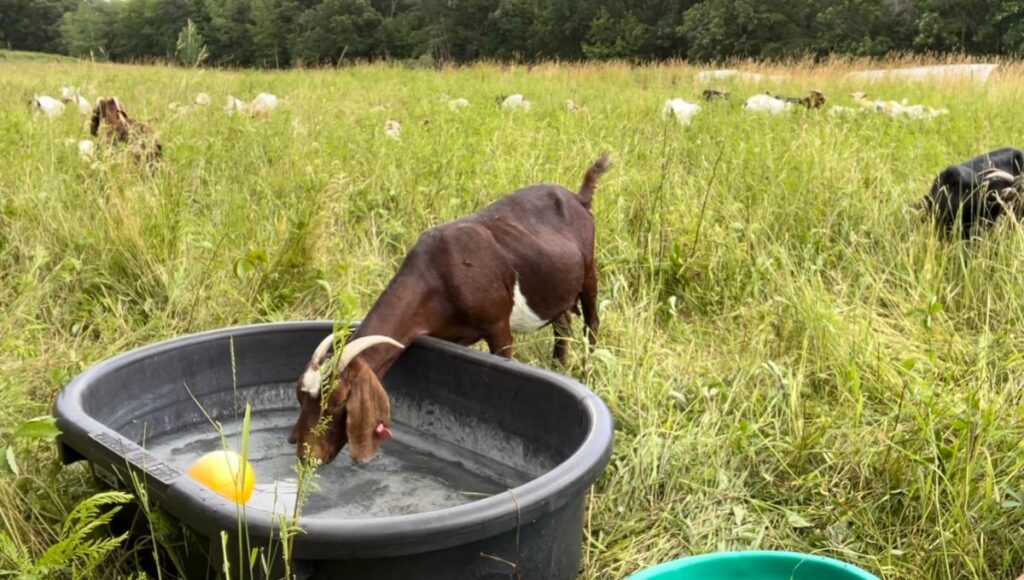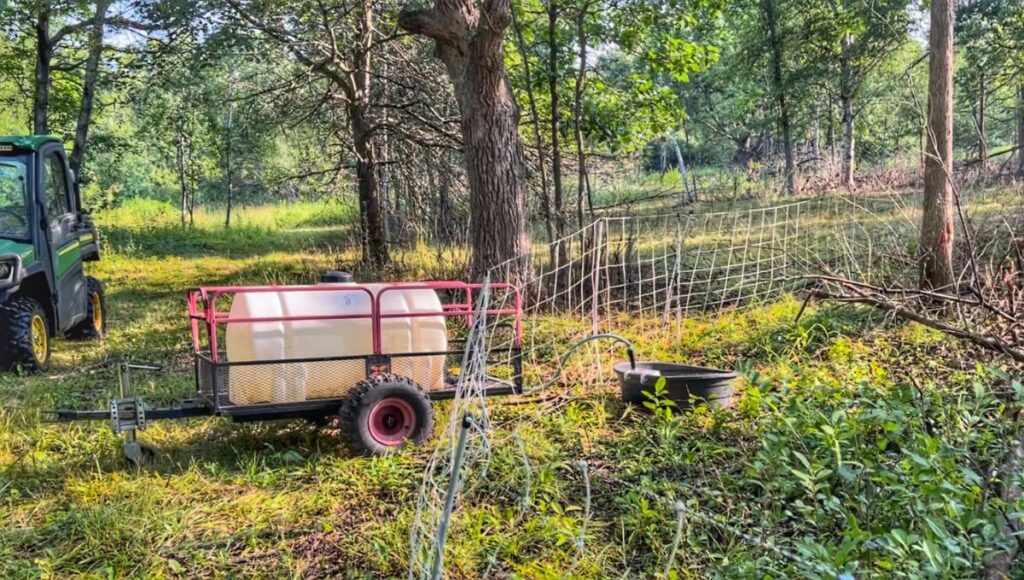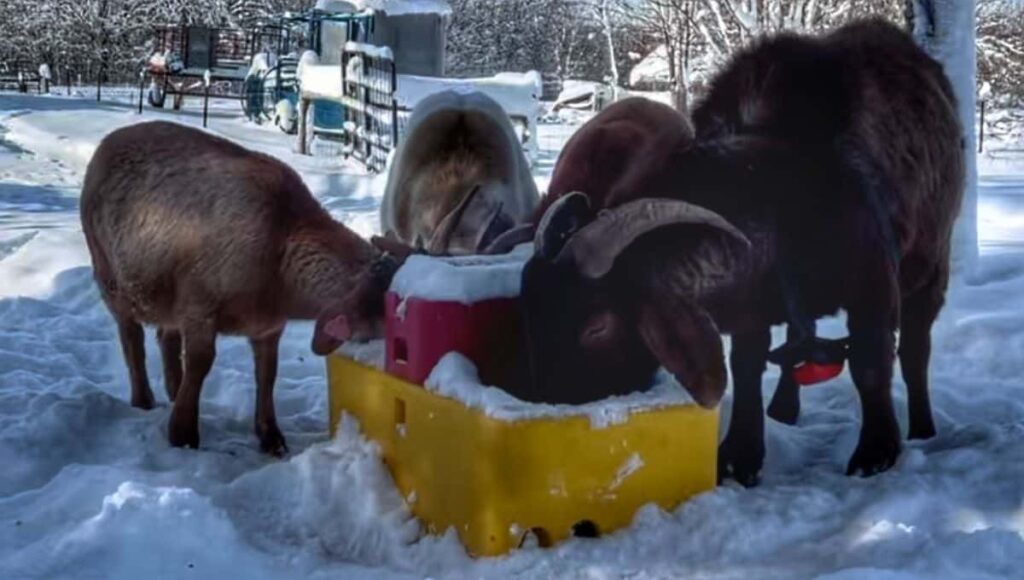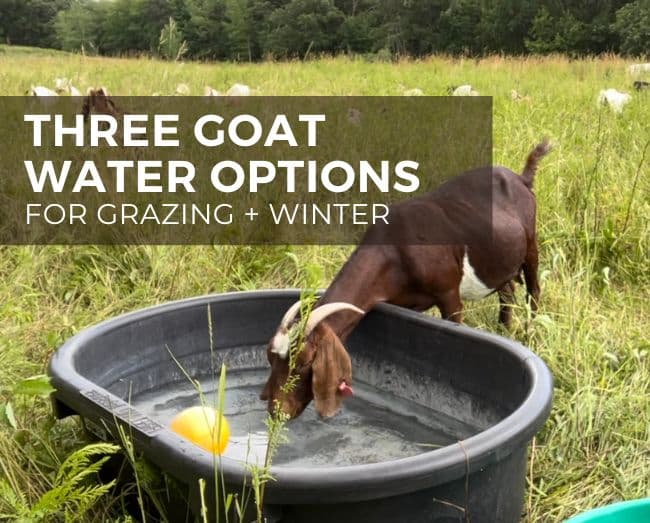As an Amazon Associate I earn from qualifying purchases.
Access to water is critical for your goats, but it can be also time consuming to fill waters on a regular basis. This blog covers three options for goat waters that can be used during the summer grazing summer or winter.
1. Rotational grazing water system with a pipeline
The above ground black poly pipeline rotational grazing water system takes a little work to set up, but it is defiantly doable for someone wanting to DIY.
This pasture water system is set up with black ¾ poly pipe running from a water hydrant. The pipe then runs the perimeter of the designated pastures.
Along the pipeline, there will be access points with grazing quick couplers, which are basically an easy way to plug in a garden hose and livestock tank to the pipeline.
The livestock tank has an automatic float valve on it, so when the hydrant is on it will keep the water tank filled no matter how much water your goats drink.
Benefits of the pasture water system for livestock
Benefits include:
- Access to water throughout your entire pasture
- No need to haul a water tank on a trailer
- Works great as a cell grazing watering system with the right placement of outlet and use of garden hoses to move tanks

2. Remote pasture water system for livestock
Our water system for our remote pastures is a gravity livestock water system. We have two versions, which you can see in the YouTube video in this blog post.
The gravity water system is set up with a water tank on a trailer with a shut off valve. Attached to the valve is a garden hose, that is connected to an automatic water float on a tank.
I prefer to use smaller water tanks in this set up so the water doesn’t grow algea and I don’t need to a lot of water when moving the water system to a new paddock in the pasture or woods.
Benefits of a remote water system
- Very easy to set up and manage, making it a great DIY goat water trough set up
- No major infrastructure set up required
- In cold climates you can use it during the fall before hard freezing sets in

Common components for these goat water troughs
These two systems for goat water troughs use several of the same components, which make them fairly easy to set up and manage with getting water to your goats.
These components include:
- Automatic float valve
- Garden hose
- Quick connects
- Livestock water tank
3. Frost-free waterer
In the winter we use Ritchie frost free goat water troughs. We’re using the omni model designed for small ruminants, so even our smallest goat kids can access the water.
I’ll cover this type of waterer and other winter water options for goats more in a future blog post.

Tools and equipment used for goat watering systems
These materials are used in the first two options covered above:
- Automatic float valve – bottom float from Jobe and an over the top tank float
- Garden hose – I like the Flexzilla hoses since they get tangled less and don’t get stiff with age
- Quick connects for garden hoses
- Plasson quick couplers for use with poly pipe line
- Quick coupling riser (key)
- ¾ black poly pipeline
- Stock water tanks – 60 gallon poly tank
- Small mineral tubs for young stock
- Trailer
- Chlorine tabs for keeping water clean and minimizing algae build up
Note: The link(s) above is an affiliate link.
How to keep livestock water tanks clean
Keeping livestock water tanks clean comes down to a few basics. First, make sure water isn’t sitting in the tank for too long. A smaller tank with a float can help solve this problem, so water is regularly moving through the tank.
Second, regularly cleaning out the tank with a scrub brush is helpful. When you start to see build up, scrub the tank and dump out the water. Repeat as necessary until the debris is gone.
We also use a little bit of chlorine in our stock tanks to help keep them clean and reduce build up. We use 1 inch chlorine tabs used for swimming pools. Depending on the size of the tank, I’ll drop in one tab or break it into smaller pieces.
Clean waters ensures your goats are getting enough water, especially with the summer heat.
Algae control in livestock water tanks
Algae can be an issue fast with standing water in livestock tanks. There are a number of strategies that can be used to help manage algae growth. A few popular approaches include using apple cider vinegar or even using goldfish.
Our use of chlorine tabs, as noted above, helps keep algae from building up in our goat water troughs.
Video of three options for goat waters
Related blog posts

LEAVE A COMMENT
Comments